By Alejandra Corona-Ortega, Sara Harris, Elijah Mas, and Ben Wong
Success Academy is billed as the largest, highest performing charter network in New York City, but is that the entire story? At first glance, the results point to significantly high student performance, especially compared to the surrounding New York City public schools. There has been no lack of controversy, however, surrounding this network, especially related to disciplinary policies, potentially biased enrollment, and fiscal management. In light of allegations and mixed reactions, the network has often failed to provide transparent explanations for their actions or solutions. This leaves room for skepticism that Success Academy is not actually meeting the needs of the entire student population within the context of NYC public schools, even considering reports of such high performance. After weighing the existing data on student outcomes against counter claims we believe that Success Academy as it stands provides NYC families with a quality alternative to traditional public schools, but we do not support the network’s plans for rapid expansion until it improves transparency and public accountability.
Methods
In order to evaluate data on Success Academy, we conducted a random drawing of six Success schools using an online random number generator. We then compared federal and state data for these six schools with data for the school districts geographically surrounding them. Student demographic and discipline data were collected from the NCES Elementary and Secondary Information System. Student achievement and attrition data, albeit limited, were collected from the NYSED data site. We made extensive use of Success Academy’s website in order to understand the network’s unique brand and student experience. Realizing that Success Academy’s own marketing materials are heavily biased, we also sought news articles, employee reviews, and independent reports that highlight potential counter-narratives from teachers, parents, and other stakeholders.
History, Mission, and Pedagogy
Eva Moskowitz, an educator and leader in different levels of education and government, founded Success Academy in 2006. The network currently has 41 schools and educates 14,000 K-12 students. It utilizes lottery admission.
The stated purpose of the organization is the realization of success in children from all backgrounds. Ninety-three percent of students in Success schools are students of color (SOC), according to the organization’s website.
Success schools are driven by a holistic pedagogy, with a focus on critical thinking, core knowledge, cultural experiences, independent study and electives for secondary students, and college readiness, the precursors of which begin in the earliest years. In the upper grades, independent learning is stressed, and students are offered different opportunities for enrichment (elective courses, summer programs, etc.). STEM is an important part of the curriculum, and a special STEM diploma is available for high school students who choose to pursue it; even kindergarteners do science experiments.
Students are expected to hold themselves accountable, challenge themselves to grow, and persevere through difficulty. The organization seeks to foster a sense of community within its walls and in its neighborhoods; students are encouraged to support one another, and parental involvement is expected (Success Academy Official, 2017).
That Success students truly learn to be independent is, of course, not guaranteed. An evaluation of the Bronx 2 school (one of the schools in our sample) in the 2010-11 term by SUNY’s Charter Schools Institute (SUNY-CSI) reported that teachers indeed challenged students academically and encouraged a variety of thinking skills. However, it also found the following:
Teachers implement the school’s comprehensive behavior or management system with fidelity… They use various tactics to elicit class attention or compliance, such as clapping hands or repeating ‘track’ and other key phrases. Occasionally teachers demand 100 percent compliance with directions, requiring multiple admonitions that interfere with the flow of the lesson and learning time. … Teachers continually provide students with directions and praise for quiet student activity and quick transitions.
SUNY-CSI reports that the positive effect of this culture is that students understand clear expectations that they will not disrupt the learning process. It also states that with regard to the school, “the great majority of parents… have strong positive attitudes.” (Charter Schools Institute, 2011) The long-term impacts of this kind of instruction, however, remain nebulous.
Demographics
To examine whether Success abides by its principle of maximizing the potential of students from all backgrounds, we briefly examined the schools’ demographics in the 2014-15 term. In most cases, the sample schools have higher SOC enrollment than their surrounding districts. Two of the three districts in which these schools are located have similar SOC concentrations to Success Academy on the whole:

The distributions vary for students who are traditionally disadvantaged because of economic or language barriers:

Both Hell’s Kitchen and Harlem 5 have significantly lower concentrations of free/reduced-lunch students than their surrounding districts, and Cobble Hill also has a smaller (but still measurable) difference. Most schools (save for Harlem 5) have low rates of ELL enrollment, both in absolute and district-relative terms.
Student Achievement
(Note: Certain data elements for different schools were not available, and no data are available for Hell’s Kitchen or Crown Heights. All data shown pertain to the 2014-15 term.)
Where state-level data is available, Success Academy schools tend to dramatically outperform their city and districts, with the strongest gains observed in math. This maintains across demographic groups, including traditionally underrepresented/disadvantaged students:
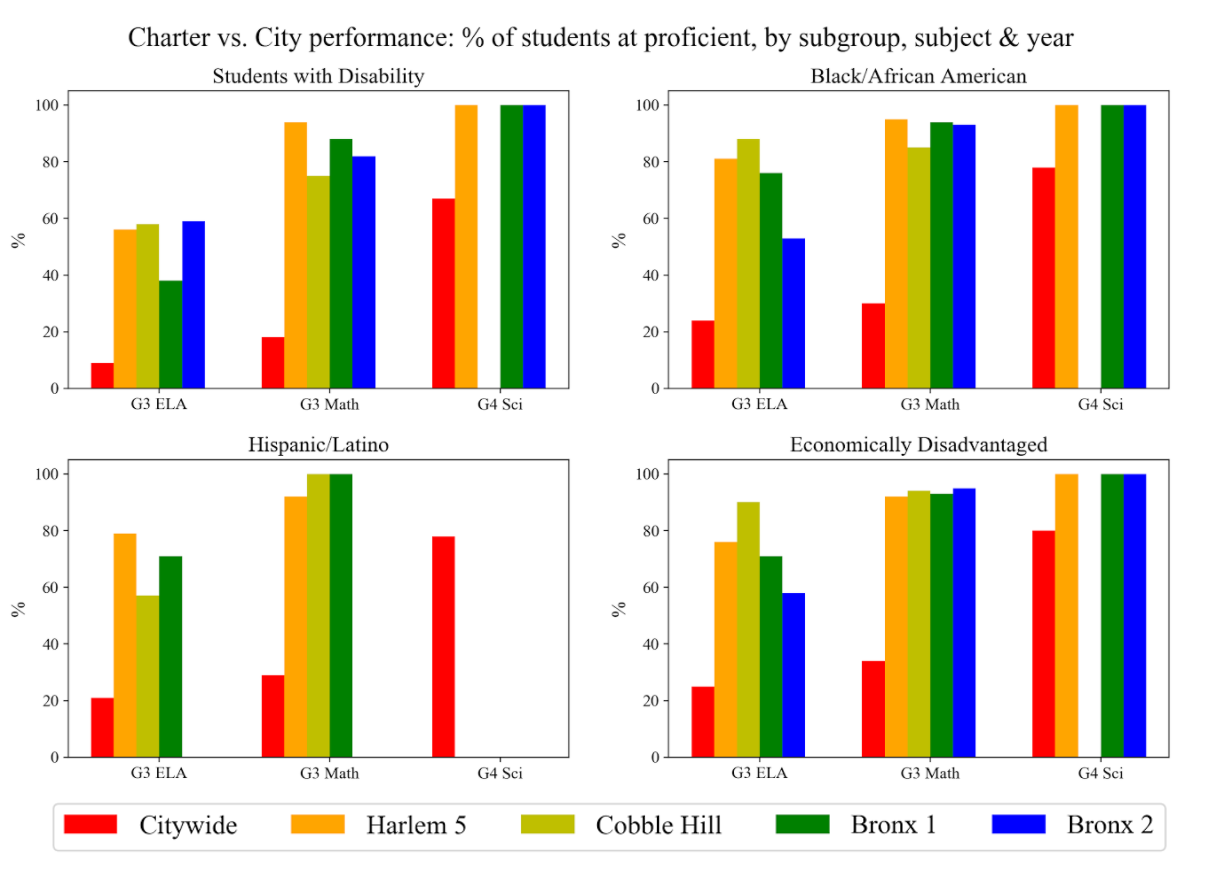

Figure 4 provides the district comparisons for third grade students:
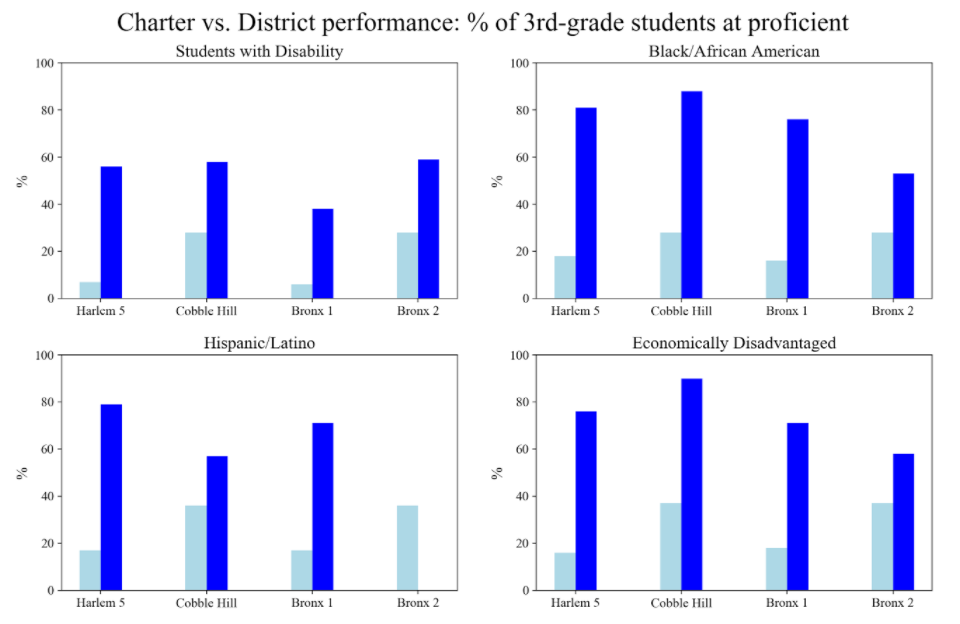
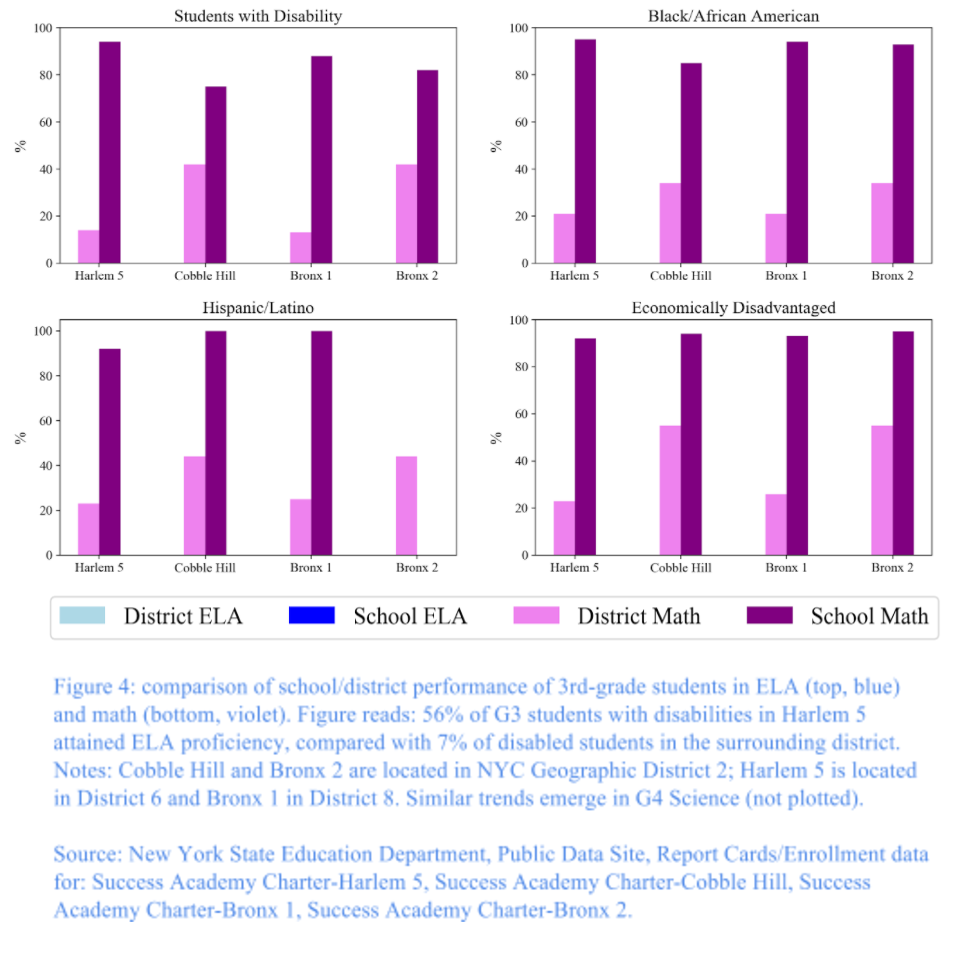
Bronx 2 is the only school with available (albeit limited) data on ELL students are; as expected, proficiency rates are higher for ELL students in Success schools.
In addition to state/district comparisons, it is important to examine whether Success closes achievement gaps within its own walls. In terms of economic disparities (the only comparison for which we had sufficient data), it seems that this is what Success does:
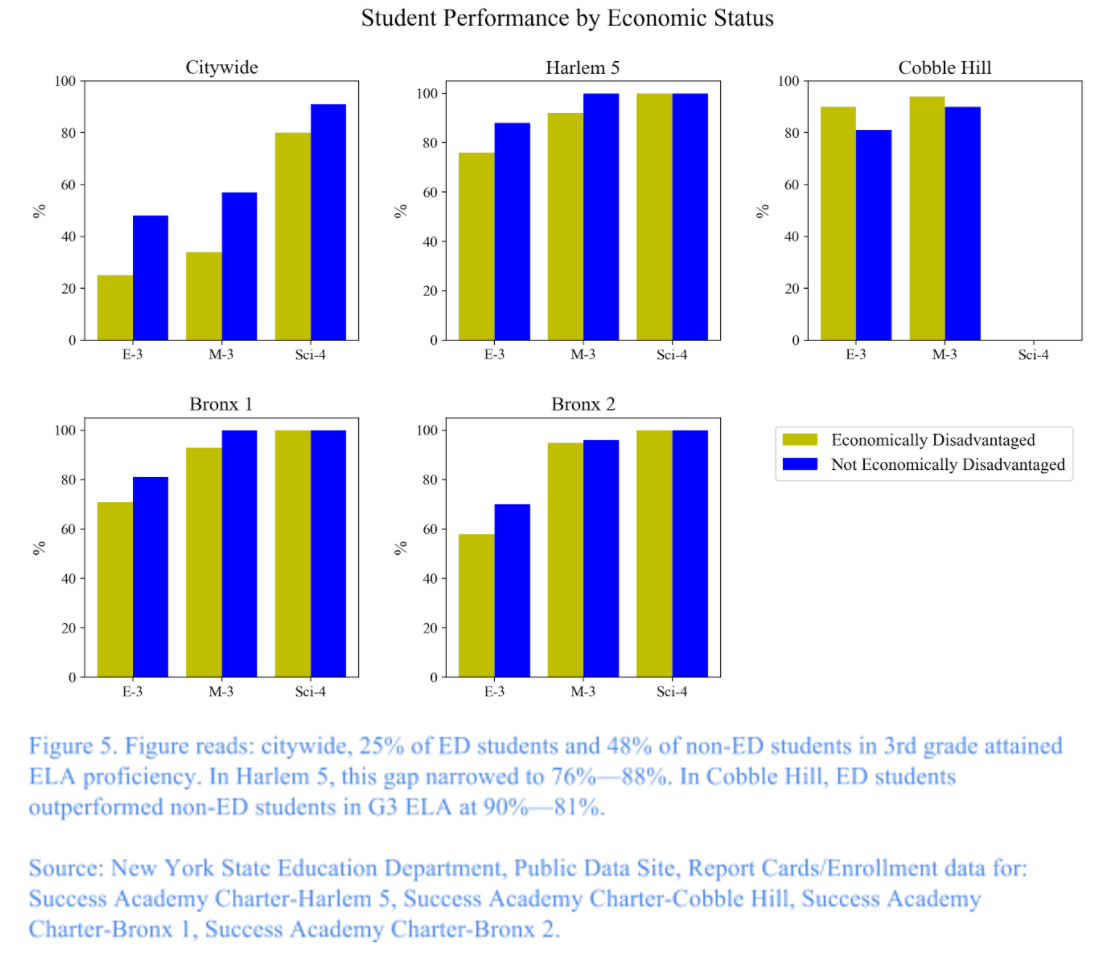
In Cobble Hill, disadvantaged students outperform non-disadvantaged students. Due to lack of data, we do not know whether this trend continues beyond 3rd grade. Recall that in our sample, Cobble Hill has the lowest FRL concentration and second-lowest ELL concentration.
Success students perform highly, but why they exhibit this performance is beyond the scope of this data. Selection effects, attrition, or other factors could account for this; it is also possible that the quality of the schools is the dominant reason for the observed differences. We realize that proficiency rates are only one measure of attainment, which does not reveal more-detailed score distributions.
Data on student attainment beyond the Success chain are difficult to find. Diane Ravitch reblogged an article from the NY Post telling that very few Success students have gotten into the most-selective NYC public high schools: 0 in 2014, 0 in 2015, and 6 in 2016. It is possible, as Moskowitz alleges, that the low rate of acceptance is due to the fact that students are not coached for these exams (Ravitch, 2016). It is also possible that the apparent performance of Success students is exaggerated while they are in the charter system.
School Discipline
Success Academy is renowned for its students’ high achievement. While its website makes no mention of a no-excuses policy, it emphasizes the importance of maintaining high standards and personal responsibility. Moskowitz has continuously spoken about her support of the use of suspensions and other common “no-excuses” strategies such as the enforcement of uniforms (Feldman, 2017). According to SUNY-CSI, Success instructors do not accept even minor forms of misbehavior, an approach which bears semblance to the broken-windows ideology behind no-excuses models (Charter Schools Institute, 2011). Still, in 2016 the organization’s Chief Academic Officer Michele Caracappa spoke out against the no-excuses label:
In contrast, our analysis of racially disproportionate discipline in randomly selected schools reveal Success’ higher rates of out-of-school suspensions than the surrounding district:
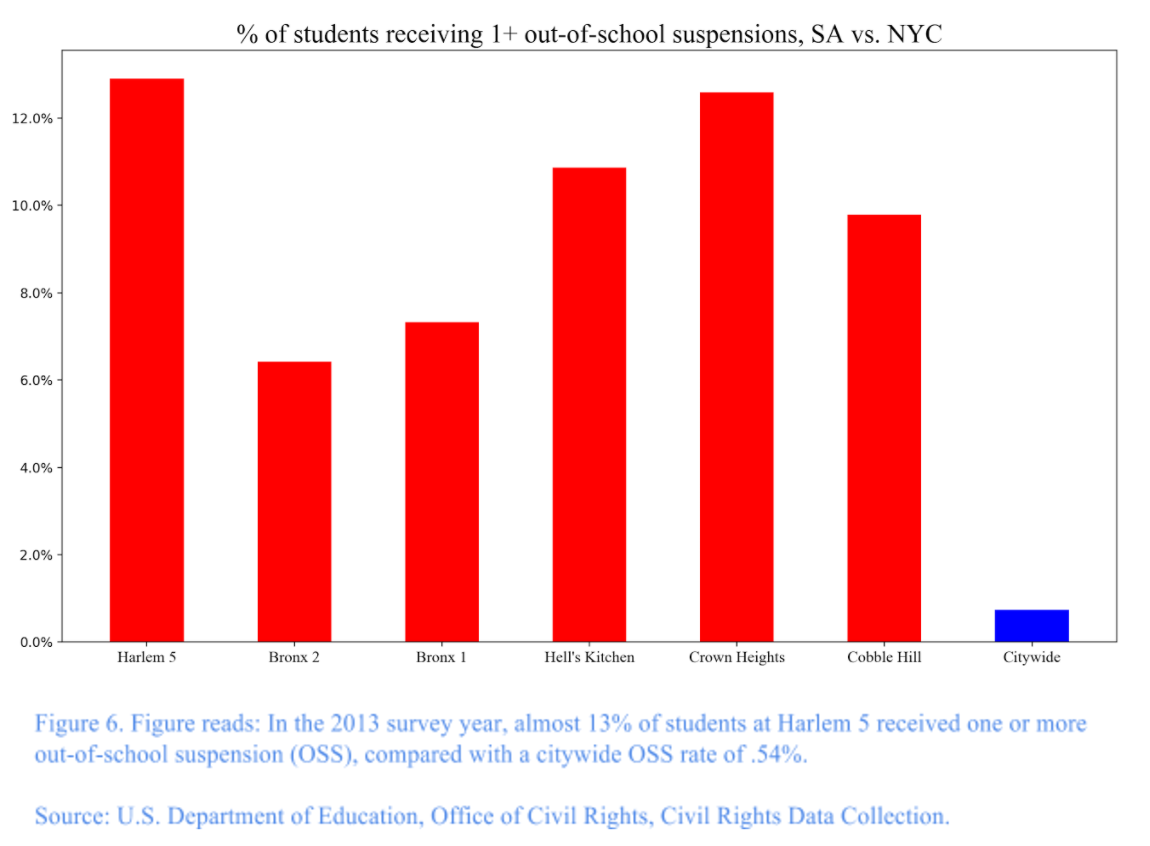
It is important to note that district schools tend to discipline a higher proportion of the students using in-school-suspensions. The charter schools did not practice in-school suspension (click here for our work on discipline demographics). The network has been attacked for refuting the findings of the U.S. DOE declaring these practices discriminatory. Success Academy has been found to suspend seven times more students than district schools that serve the same age group (Casey, 2015). We were unable to find raw data on arrests or violent crimes occurring in Success schools.
Their discipline model has also continued to fall under scrutiny. One of the most notable episodes occurred when a math teacher was recorded screaming at a first-grader who failed to answer a question during class (Taylor, 2016 Feb.). The network was also criticized after the New York Times found documents revealing a “Got to Go” list of students that the administrators of a Success school thought were detrimental to school quality. The parents of some students on the list mentioned that administrators had told them repeatedly that the school was not a good fit for the children (Taylor, 2015 Oct.).
Consistent with the “Got to Go” list, there is consistent evidence of attrition between grades 3 and 5:

These data reinforce the idea that charter schools are successful because they can choose their students. We saw the high levels of out-of-school suspension that Success Academy practices (Fig. 6), which along with practices that make parents or students unwelcome could explain the lower number of students in subsequent grades. These data suggest that the schools are making sure to only have children who comply with the organization’ model of teaching and discipline which, leading many families to opt out of the schools. Contrary to public district schools, which cannot choose the students they serve, charter schools could improve their scores and discipline compliance by literally ostracizing kids from their schools.
Marketing & Media
Success Academy prioritizes two standards of their schools on their website, which is their main source of marketing: student success, and accessibility to all students interested. In the section titled “Who We Are” their performance, rigor, and credibility is prioritized. This section states that they are “ the largest and highest-performing free, public charter school network in New York City”, and also that enrollment is open to all students. Enrollment statistics for historically disadvantaged, under-supported groups— such as low-income students, current and former English Language Learners, current and former special needs student and students of color—are made easily available.
The network is attempting to demonstrate a dedication to high performance, accessibility and inclusion by including this information in an extremely visible, accessible portion of the website. In the growing market of charter schools, networks often market themselves to a specific audience of parents and students. Wilson and Carlsen examined differences in marketing techniques by different charter schools, categorizing schools by the groups their marketing targeted. Success Academy fits the parameters of the “Progress Oriented” category, defined by Wilson and Carlsen as having an emphasis on achievement, “group-based instructional strategies”, and “coherent school culture”. This targeted marketing understandably affects the student population that chooses to pursue enrollments (Wilson & Carlsen, 2016).
Their mission statement echoes these goals, stating their goal to “Build exceptional, world-class public schools that provide children from all backgrounds can succeed in college and life…” the graphics below demonstrate the most used words in their “About” section, which highlights their marketing focus on academics and diversity in curriculum, as well as focus on rigor and outcomes by using words such as “scholars” and “achievements”.
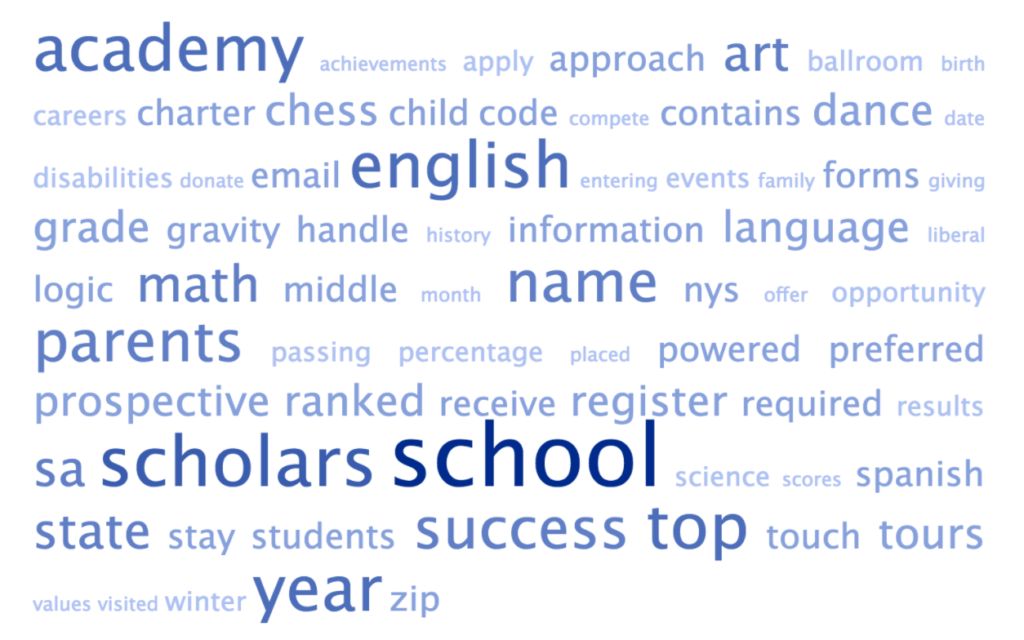
Accountability and Oversight
NYC Comptroller Scott Stringer released an audit report of Success Academy from fiscal years 2013 to 2015, noting “serious concerns” about the network’s insufficient fiscal oversight. One of the audit’s most salient findings was an overcharge of $51,000 for special education services to the NYC Department of Education, but no evidence that Success Academy actually provided those services to students. The report also criticizes the network for unreported expenditures and improper loan documentation (Stringer, 2016).
In response to the Comptroller’s Office, Success denounced the audit as an empty political ambush (Harris, 2016). Instead of reacting bitterly to the audit report, however, the charter network may have drawn less scrutiny if it simply acknowledged the financial irregularities and made the appropriate repayments without fanfare. At the same time, the Comptroller’s Office may have exaggerated the significance of its findings. Although Success Academy should be held accountable for taxpayer dollars, the report did not find any evidence of fraud or criminal behavior, and poor record keeping does not necessarily imply darker motivations. Additionally, the magnitude of the fiscal mismanagement in question is relatively small compared to the network’s multimillion-dollar budget. The audit’s findings provide little reason to believe that these instances of fiscal mismanagement are systemic.
That said, Success Academy should accept and respect the Comptroller’s audit and simply work to make accountability an even higher priority in the future. One way in which the network can begin improving accountability is by sharing more details about the formal duties and practices of its Board of Directors. While biographies of board members are listed on Success Academy’s website, the board has yet to publicly disclose important information about CEO oversight, ethics and transparency, and board selection and self-assessment procedures (GuideStar, 2017). Sharing these details will ensure Success leadership is fulfilling its legal and fiduciary obligations to the network’s students.
Funding
A mixture of public and philanthropic dollars funds Success Academy schools. In 2014 the network earned nearly $42.5 million in revenue, consisting primarily of contributions, grants, and funding from New York for the operations of its schools. In the same fiscal year, 63% of the network’s revenue paid for program services directly benefiting students. The remainder went toward administrative costs and fundraising expenses. The sources of these 37% in overhead costs are unclear, but the network’s Form 990s reveal that top executives receive hundreds of thousands of dollars in annual compensation plus bonuses. The network earned a net profit of $9.25 million (GuideStar, 2017).
The fact that over one-third of Success Academy’s revenue goes to overhead costs instead of student programs raises skepticism in light of its most recent skirmish with New York City Mayor Bill de Blasio. Moskowitz refused to sign a contract with a city that entitled them to $720,000 in funding for the network’s pre-kindergarten program because she believed the contract would have given the city too much oversight (Taylor, 2016). But the network’s outrage over the forgone $720,000 seems unwarranted given its millions of dollars in remaining revenue after subtracting current program costs. Using its existing funds to keep the pre-K program afloat would not place much of a financial burden on the network, which raises questions about ulterior fiscal motives Success may have had in this most recent feud with the city.
Private donations are solicited in order to build new schools. For example, hedge fund billionaires Julian H. Robinson and John Paulson collectively gifted $33.5 million to Success in the past two years, which Moskowitz says will help the network expand to 100 schools by 2024 (Taylor, 2016). Many pro-Success hedge fund managers like Paulson also actively support the Trump administration, which explicitly endorses choice policies such as charter schools, vouchers, and magnet schools. Hedge Clippers released an incisive report condemning Success Academy for accepting major gifts from hedge fund board members who support conservative social and economic policies that harm the disadvantaged populations that Success intends to serve. The report identifies several managers and their spouses who are tied to the charter network, several of whom presumably champion school choice and other conservative education policies on the Trump administration’s policy agenda (Hedge Clippers, 2015). It is unclear whose interests these private philanthropic donors have in mind.
Staffing
Success Academy teachers receive “extensive professional development from experienced teachers and talented school leaders” according to Success’ website. A position called “Associate Teacher” is used as a stepping stone to a “Lead Teacher” position. Associate teachers are supposed to receive more support from their peers and professional development on their way to a Lead position. Many of the new teachers are recent graduates. There are mixed reviews from former Success teachers who held many different positions. Some past teachers praise the network’s support and professional development, while others criticize the high-stress and demanding environment (“Reviews”, 2016). It is unclear if this variance stems from differences in specific Success schools, or differences in positions. There have also been high turnover rates reported at many Success schools, as high as 50% at several. The transparency and interpretation of this data has not been straightforward, as Success Academy representatives have pushed back, stating that these numbers are inflated due to intra-network transfers counted as teacher resignations. Critics have cited New York Department of Education statistics which show overall retention rates below 70%, and same-school retention rates around 50% (Di Carlo, 2015).
Teacher diversity, or purported lack thereof, has been another publicized topic surrounding Success Academy. Cited statistics from the Teachers Diversity Committee of NYC showed that the percentage of white teachers at several Success schools during the 2013-14 school year was significantly higher than the district average of 58.6%, some seeing this number climb past 90% (“Success Academy Charter School Staff Diversity”).
Relationship to the District
Success Academy is often revered as a high-quality charter network where predominantly minority children in New York City have access to a challenging education that often puts them ahead of suburban schools. However, this praise is far from ubiquitous. Since entering office, NYC Mayor Bill de Blasio has opposed Moskowitz’s commitment to expanding charters because he believes networks like Success siphon off money from district schools. (Bergner, 2014). While some Success Academy parents believe the network is preparing their children for the future better than their traditional public schools, others resent the levels of discipline in the school and began looking for other options for the following year (Spear, 2015). In an extreme case of communal distrust, this past March a Success school co-located with M.S. 145, a NYC school in danger of being closed. M.S. 145 was promised three years to turn itself around, but Success Academy had prematurely moved into the space, creating tensions with the neighborhood community. There is suspicion that the charter network has greater sway in the decision to close M.S. 145 and plans to remain there once M.S. 145 closes (Vinopal, 2017). Despite these problems, however, there are signs that the charter is certainly trying to collaborate with educators in traditional public schools. According to the NYC Charter School Center, Success Academy hosted a professional development workshop for educators across the city to discuss best pedagogical practices (Reinish, 2015).
Conclusion
Success Academy sells itself as a mission-driven organization dedicated to the success of all students and improvement of pedagogy. Scholarliness and accessibility are its most prominently stated goals, and it supplies that 93% of its students are of color. State data reveal superior performance in Success schools in the youngest grades, and we expect nothing different for higher ones. As the network stands today it has had a net positive impact on public education for NYC students and families, even in spite of criticism of its discipline policy that echoes other charter networks’ “no excuses” philosophy. That said this criticism leads us to question whether Success Academy’s laser-like focus on academic excellence comes at the expense of other student outcomes, such as their socio-emotional and behavioral health. More data on how students fare beyond Success Academy are needed to evaluate this claim.
Furthermore, we demand greater transparency from the network before supporting their expansion to 100 schools by 2024. Even our brief examination shows high variability in FRL enrollment, deficits (some minor) in ELL enrollment, and high rates of suspension. Success touts the quality of its teachers and professional development, but it may harbor unhealthy, detrimental professional environments. Different individuals and offices have attested or probed claims that Success denies opportunity to all students and makes unfair use of public funding; Success officials staunchly deny this. We believe that the Success Academy’s growth must be accompanied by increased public accountability to ensure that all NYC district students have fair and equal access to its opportunities for academic enrichment, as well as to ensure that the network is not abusing public funding that traditional public schools unquestionably need.
References
Bergner, D. (2014). The Battle for New York Schools: Eva Moskowitz vs. Mayor Bill de Blasio. The New York Times. Retrieved from https://www.nytimes.com/2014/09/07/magazine/the-battle-for-new-york-schools-eva-moskowitz-vs-mayor-bill-de-blasio.html
Cassey, L. (2015, October 19). Student Discipline, Race And Eva Moskowitz’s Success Academy Charter Schools. Albert Shanker Institute. Retrieved from http://www.shankerinstitute.org/blog/student-discipline-race-and-eva-moskowitz%E2%80%99s-success-academy-charter-schools
Charter Schools Institute (2011, October 6). Bronx Success Academy Charter School 2: School Evaluation Report, 2010-11.
Di Carlo, M. (2015, April 09). Teacher Turnover At Success Academy Charter Schools. Albert Shanker Institute. Retrieved March 30, 2017, from http://www.shankerinstitute.org/blog/teacher-turnover-success-academy-charter-schools
Feldman, C. (2017, March 23). Why charter school leader Eva Moskowitz, a Democrat, is going to bat for Betsy DeVos. ChalkBeat: Education News, In context. Retrieved from http://www.chalkbeat.org/posts/ny/2017/03/23/eva-moskowitz-talks-about-betsy-devos-vouchers-discipline-and-how-the-tide-is-turning-for-charter-schools/.
Harris, E. A. (2016, December 19). Success Academy May Have Overcharged City for Special Education Services, Audit Says. Retrieved March 30, 2017, Retrieved from https://www.nytimes.com/2016/12/19/nyregion/success-academy-audit.html?_r=0
Ravitch, D. (2016). Success Academy Students Finally Gain Admission to Elite High Schools. Diane Ravitch’s Blog. Retrieved from https://dianeravitch.net/2016/06/17/success-academy-students-finally-gain-admission-to-elite-high-schools/
Reinish, J. (2015). Nyc Collaborates Hosts Success Academy In A Highly Sought-After Professional Development Workshop For Hundreds Of District & Charter School Educators; One Of Nyc’s Highest-Performing Charter Networks Shares Unique Approach To Close Reading. New York City Charter School Center. Retrieved from http://www.nyccharterschools.org/content/nyc-collaborates-hosts-success-academy-highly-sought-after-professional-development-workshop
Reviews, Success Academy Charter Schools. (2016). Retrieved April 01, 2017, from https://www.indeed.com/cmp/Success-Academy-Charter-Schools/reviews
Spear, A., Ling, A., & Bengiveno, N. (2015). Stories From Current and Former Success Academy Parents. The New York Times. Retrieved from https://www.nytimes.com/interactive/2015/04/17/nyregion/success-academy-parents-voices.html
Stringer, S. M. (2016, December 19). Audit Report of Success Academy Charter Schools (Rep.). Retrieved March 30, 2017, from City of New York Office of Comptroller website: https://comptroller.nyc.gov/wp-content/uploads/documents/FK15_092A.pdf
Success Academy Charter Schools. (2017). Retrieved March 30, 2017, Retrieved from https://www.guidestar.org/profile/20-5298861
Success Academy Charter School Staff Diversity: Why is the Staff Overwhelming White? Tone Deaf? By Choice? A Diverse Workforce is Essential in the 21st Century. (2015, October 20). Retrieved April 1, 2017, from https://mets2006.wordpress.com/2015/10/20/success-academy-charter-school-staff-diversity-why-is-the-staff-overwhelming-white-tone-deaf-by-choice-a-diverse-workforce-is-essential-in-the-21st-century/
Success Academy Official (2017). About. Success Academy Charter Schools. Retrieved March 28, 2017, from http://www.successacademies.org/about/
Taylor, K. (2015, October 29). At a Success Academy Charter School, Singling Out Pupils Who Have ‘Got to Go.’ The New York Times. Retrieved from https://www.nytimes.com/2015/10/30/nyregion/at-a-success-academy-charter-school-singling-out-pupils-who-have-got-to-go.html?_r=0.
Taylor, K. (2016, February 12). At Success Academy School, a Stumble in Math and a Teacher’s Anger on Video. The New York Times. Retrieved from https://www.nytimes.com/2016/02/13/nyregion/success-academy-teacher-rips-up-student-paper.html?_r=0
Taylor, K. (2016, February 26). Success Academy Loses in Pre-K Battle With de Blasio Administration. Retrieved April 23, 2017, from https://www.nytimes.com/2016/02/27/nyregion/success-academy-loses-in-pre-k-battle-with-de-blasio-administration.html
Taylor, K. (2016, April 12). Success Academy Charter School Network Receives $25 Million Gift. Retrieved March 30, 2017, Retrieved from https://www.nytimes.com/2016/04/13/nyregion/success-academy-charter-school-network-receives-25-million-gift.html?_r=0
The Double Standard of Success Academy (Rep.). (2015). Retrieved March 30, 2017, from Hedge Clippers website: http://hedgeclippers.org/wp-content/uploads/2015/04/HP10.pdf
Vinopal, C. (2017, March). Fighting for a School Designated to Close. NY City Lens. Retrieved from http://nycitylens.com/2017/03/fighting-school-designated-close/
Wilson, T. S., & Carlsen, R. L. (2016). School marketing as a sorting mechanism: A critical discourse analysis of charter school websites. Peabody Journal of Education, 91(1), 24-46.
